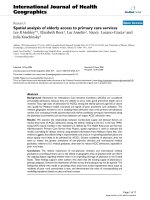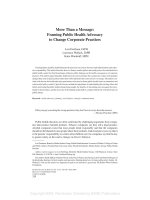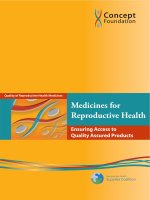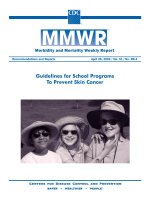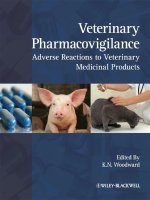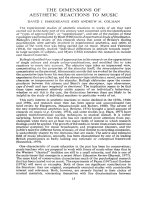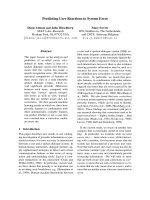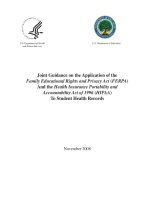Veterinary Pharmacovigilance Adverse Reactions to Veterinary Medicinal Products docx
Bạn đang xem bản rút gọn của tài liệu. Xem và tải ngay bản đầy đủ của tài liệu tại đây (6.11 MB, 779 trang )
Veterinary Pharmacovigilance
Adverse Reactions to Veterinary
Medicinal Products
Edited by
K.N. Woodward
A John Wiley & Sons, Ltd., Publication
Veterinary Pharmacovigilance
Veterinary Pharmacovigilance
Adverse Reactions to Veterinary
Medicinal Products
Edited by
K.N. Woodward
A John Wiley & Sons, Ltd., Publication
This edition fi rst published 2009
© 2009 Blackwell Publishing Ltd.
Wiley-Blackwell is an imprint of John Wiley & Sons, formed by the merger of Wiley’s global Scientifi c, Technical and Medical
business with Blackwell Publishing.
Registered offi ce
John Wiley & Sons Ltd, The Atrium, Southern Gate, Chichester, West Sussex, PO19 8SQ, United Kingdom
Editorial offi ce
John Wiley & Sons Ltd, The Atrium, Southern Gate, Chichester, West Sussex, PO19 8SQ, United Kingdom
For details of our global editorial offi ces, for customer services and for information about how to apply for permission to reuse the
copyright material in this book please see our website at www.wiley.com/wiley-blackwell.
The right of the author to be identifi ed as the author of this work has been asserted in accordance with the Copyright, Designs and
Patents Act 1988.
All rights reserved. No part of this publication may be reproduced, stored in a retrieval system, or transmitted, in any form or by
any means, electronic, mechanical, photocopying, recording or otherwise, except as permitted by the UK Copyright, Designs and
Patents Act 1988, without the prior permission of the publisher.
Wiley also publishes its books in a variety of electronic formats. Some content that appears in print may not be available in
electronic books.
Designations used by companies to distinguish their products are often claimed as trademarks. All brand names and product
names used in this book are trade names, service marks, trademarks or registered trademarks of their respective owners. The
publisher is not associated with any product or vendor mentioned in this book. This publication is designed to provide accurate
and authoritative information in regard to the subject matter covered. It is sold on the understanding that the publisher is not
engaged in rendering professional services. If professional advice or other expert assistance is required, the services of a competent
professional should be sought.
Library of Congress Cataloging-in-Publication Data
Veterinary pharmacovigilance : adverse reactions to veterinary medicinal products / Kevin N. Woodward, editor.
p. cm.
Includes bibliographical references and index.
ISBN 978-1-4051-6968-4 (alk. paper)
1. Veterinary drugs Side effects. I. Woodward, Kevin N.
SF917.V495 2009
636.089’57042–dc22
2008044761
A catalogue record for this book is available from the British Library.
Set in 10.5 on 14 pt Palatino by SNP Best-set Typesetter Ltd., Hong Kong
Printed and bound in Singapore by Markono Print Media Pte Ltd
1 2009
To Diana, Alastair, Frances and Felicity
And to Jenny, Sally and Patsy, to Alfi e and Molly,
and to Jack Russell Terriers everywhere.
Contents
7 Veterinary adverse drug event
reporting in the United States,
Australia and Canada 119
K.N. Woodward
8 Veterinary pharmacovigilance:
a South African perspective 151
V. Naidoo
9 Pharmacovigilance inspections in the
European Union 163
K.N. Woodward and C.W. Evans
10 Essential elements of veterinary
pharmacovigilance and the role and
duties of the Qualifi ed Person 177
B. Cornez
11 Veterinary pharmacovigilance in an
industry setting – the European
Union 209
M. O’Gorman
12 Pharmacovigilance in the US – an
industry perspective 231
T.M. Hodge
13 Practical veterinary
pharmacovigilance 287
D. O’Rourke
List of contributors ix
Preface xi
Acknowledgements xiii
Introduction 1
D. Skilton
1 Elements of veterinary
pharmacovigilance 9
K.N. Woodward
2 Veterinary pharmacovigilance in the
European Union 19
K.N. Woodward
3 Pharmacovigilance and the European
Medicines Agency: conduct of
pharmacovigilance activities 47
K. Grein
4 Veterinary pharmacovigilance in
France 55
G. Keck and X. Pineau
5 Pharmacovigilance in Germany 65
C. Ibrahim and A. Wilke
6 Veterinary pharmacovigilance –
the UK experience 91
K.N. Woodward
14 Preclinical safety testing and assessment
of veterinary pharmaceuticals and
pharmacovigilance 297
K.N. Woodward
15 Safety assessment of veterinary
vaccines 347
M.J. Francis
16 Microbiological assessment of
veterinary medicinal products and
potential adverse effects 355
P. Silley
17 Adverse effects of veterinary
pharmaceutical products in animals 393
K.N. Woodward
18 Adverse drug reactions in dogs – toxic
hepatic responses 423
K.N. Woodward
19 Adverse reactions to vaccines 453
K.N. Woodward and L.A. Toon
20 Adverse reactions in humans following
exposure to veterinary drugs 475
K.N. Woodward
21 Medicines used to control and treat
external parasites of sheep – toxicology
and the phenomenon of reported adverse
human responses to organophosphorus
sheep dips 517
T.C. Marrs and P. Edwards
22 User safety assessment of veterinary
medicinal products 529
K.N. Woodward
23 Maximum residue limits 547
K.N. Woodward
24 Determination of withdrawal periods
for pharmaceutical products used in
food animals 569
R.C. Parker
25 Surveillance for veterinary residues 587
K.N. Woodward
26 Adverse environmental effects and
veterinary medicinal products 605
A. Tait
27 Causality in pharmacovigilance and
expectedness of adverse reactions 639
K.N. Woodward
28 Quantitative aspects of veterinary
pharmacovigilance 659
K.N. Woodward
29 Veterinary adverse reactions and crisis
management 673
K.N. Woodward
30 The role of veterinary
pharmacovigilance in risk analysis
and the infl uence of risk
perception on veterinary
pharmacovigilance 691
H.P.A. Illing
31 The role of quality assurance in
veterinary pharmacovigilance 709
R. Visanji and H. Politis-Norton
32 Concordance between results from
animal toxicology studies and adverse
reactions in animals 715
K.N. Woodward
Index 751
viii Contents
List of contributors
H. Paul A. Illing MSc PhD CSci CChem FRSC
CBiol FIBiol FRIPH FIOSH ERT
Paul Illing Consultancy Services Ltd, Sherwood,
Heswall, Wirral, United Kingdom, and Centre
for Occupational and Environmental Health,
University of Manchester, Manchester, United
Kingdom
Gérard Keck DVM MSc Pr Ag
National Veterinary School of Lyon, University
of Lyon, Marcy l’Étoile, Lyon, France
Timothy C. Marrs OBE MD DSc FRCP
FRCPath FATS FBTS
Edentox Associates, Pinehurst, Edenbridge,
Kent, United Kingdom
Vinny Naidoo BVMCh (MEDUNSA) MSc (Vet)
(Pretoria) PhD
Section of Pharmacology and Toxicology,
Department of Paraclinical Sciences, Faculty
of Veterinary Science, University of Pretoria,
Onderstepoort, South Africa
Mike O’Gorman BVetMed MBA LLM MRCVS
Intervet/Schering-Plough Animal Health,
Harefi eld, Uxbridge, Middlesex, United
Kingdom
Bob Cornez DVM
Huvepharma NV, Antwerp, Belgium
Philippa Edwards PhD
Chemical Hazard and Poisons Division, Health
Protection Agency, Chilton, Didcot,
Oxfordshire, United Kingdom
Caroline W. Evans HNC LiBiol
Veterinary Medicines Directorate, New Haw,
Addlestone, Surrey, United Kingdom
Mike J. Francis BSc PhD CBiol FIBiol
Intervet/Schering-Plough Animal Health,
Milton Keynes, Buckinghamshire, United
Kingdom
Kornelia Grein PhD
European Medicines Agency (EMEA), Canary
Wharf, London, United Kingdom
Tatty M. Hodge MS DVM MPH DACVPM
VMRA Pharmacovigilance, Pfi zer Animal
Health, Kalamazoo, Michigan, USA
Cornelia Ibrahim DVM PhD
Bundesamt für Verbraucherschutz und
Lebensmittelsicherheit,
Berlin, Germany
Declan O’Rourke MVB DipM MBA FRCVS
Ortec Consultancy, Canterbury, Kent, United
Kingdom
Roger C. Parker BSc PhD EurChem CChem
FRSC MTOPRA
Winsford Associates, Berkhamsted,
Hertfordshire, United Kingdom
Xavier Pineau DVM
CPVL (Veterinary Pharmacovigilance Centre of
Lyon), National Veterinary School of Lyon,
University of Lyon, Marcy l’Étoile, Lyon,
France
Helen Politis-Norton BPharm MSc PgD
(Pharmacovigilance)
Global Quality Audits and Compliance;
Global Compliance and Business Practices,
Schering-Plough Ltd, Welwyn Garden City,
Hertfordshire, United Kingdom
Peter Silley BSc PhD CBiol FIBiol FIFST FRSM
MB Consult Ltd, Lymington, Hampshire,
United Kingdom, and Department of
Biomedical Sciences, University of Bradford,
Bradford, United Kingdom
David Skilton BVSc MRCVS
Veterinary Products Committee, c/o Veterinary
Medicines Directorate, New Haw,
Addlestone, Surrey, United Kingdom
Alex Tai t BSc PhD
Veterinary Medicines Directorate, New Haw,
Addlestone, Surrey, United Kingdom
Lindsey A. Toon BSc PhD
Intervet/Schering-Plough Animal Health,
Harefi eld, Uxbridge, Middlesex, United
Kingdom
Ramzan Visanji MSc FRQA CBiol FIBiol
Intervet/Schering-Plough Animal Health,
Harefi eld, Uxbridge, Middlesex, United
Kingdom
Annette Wilke DVM PhD
Bundesamt für Verbraucherschutz und
Lebensmittelsicherheit, Berlin, Germany
Kevin N. Woodward BA BSc (Jt Hons) MSc
(Exp Pathol/Toxicol) MSc
(Pharmacovigilance), PhD, CBiol, FIBiol,
EurProBiol, CChem, FRSC, DipRCPath (Tox),
MTOPRA, FBTS
International Regulatory Affairs, Intervet/
Schering-Plough Animal Health, Harefi eld,
Uxbridge, Middlesex, United Kingdom
x List of contributors
Preface
When a new veterinary medicinal product is
launched into widespread use, adverse drug reac-
tions may become apparent. These may be seen in
the treated animal patients, in exposed users or as
adverse effects on the environment. Additionally,
they may manifest as excess residues of the drug
in food of animal origin. As a consequence, legis-
lation and regulatory approaches have developed
across the globe to address these issues and to
ensure that the continued safety of these pro-
ducts can be monitored and, where necessary,
that regulatory actions can be pursued to assuage
any concerns. All of these can be covered by the
single term ‘pharmacovigilance’.
This book is an attempt to survey and sum-
marise current approaches to veterinary pharma-
covigilance, to review the types of effects that
may be seen and to examine some of the scientifi c
principles involved. I hope it will prove useful
in academia, in the regulatory environment and
within the animal health industry.
Finally, I should like to pay tribute to one of
my contributors, Ramzan Visanji, who died in
October 2008. Ramzan, a person of tremendous
courage, was a great colleague and a good friend.
His advice and views will be sorely missed, as
will his fi ne sense of humour.
Readers should note that the views expressed
by the editor herein are solely the editor’s views
and they do not necessarily refl ect the views of
Intervet/Schering-Plough Animal Health.
K.N. Woodward
2008
Acknowledgements
I am most grateful to the help and support given
to me by my family during the duration of this
project. I appreciate their forbearance during
long winter evenings, weekends and holidays
and in my prolonged disappearances into my
offi ce when I am sure that something more inter-
esting (to them) would have been welcomed.
I am also grateful to all of the contributors for
their help and assistance. I would like to express
my gratitude to colleagues in Intervet/Schering-
Plough Animal Health for their help and support,
especially to Drs K.J. Varma and John Rogers,
and Mr Jim Gould. I am also grateful to those
at my publisher, Wiley Blackwell, especially to
Sophie Gillanders and Amy Brown, for their
help, and to Julie Musk whose copy-editing skills
have contributed signifi cantly to the readability
and accuracy of this book. I would like to thank
Professor Peter Lees for his helpful comments
prior to embarking on this enterprise. Thanks are
due to Dr Peter Jones and Dr Steve Sundloff
whose editorial in an issue of the Journal of
Veterinary Pharmacology and Therapeutics (2005)
(Volume 28, pp. 127–128) convinced me that this
exercise was well worth all that was likely to be
involved. Finally, I must thank those with whom
I have had numerous discussions, debates and
occasionally disagreements during the prepara-
tion of this work. To all, your contributions have
been most gratefully received.
Veterinary Pharmacovigilance is the collection and
assessment of information, including post-
marketing surveillance of the adverse effects of
veterinary medicines. An adverse effect or reaction
to a veterinary product is one that is harmful and
unintended and which occurs at doses normally used
in animals for the prophylaxis, diagnosis or treatment
of disease or the modifi cation of physiological
function.
Following the increase in knowledge and
growth of technology in the veterinary sector,
pharmacovigilance is now recognised as a vital
component in the safe and effi cacious use of vet-
erinary medicines. The purpose of a good phar-
macovigilance surveillance system is to ensure
the safety of veterinary medicines once they are
authorised and being used in the market place.
The rapid identifi cation of any adverse effects to
medicines is essential and the data produced
from the investigation should be assessed in
order to reduce risks in the future use of the
product where applicable.
When veterinary medicines are used according
to the manufacturer’s instructions, adverse effects
to the products are extremely rare. Before a
company can place a veterinary medicine in the
market place there is a requirement under
European Union (EU) and United Kingdom (UK)
legislation for a Marketing Authorisation (MA)
to be obtained. This MA is only granted after a
detailed scientifi c assessment of the product data
on quality, safety and effi cacy. Part of the legisla-
tion covering the assessment requires the Mar-
keting Authorisation Holder (MAH) to conduct
clinical trials, which will provide product details
on safety, effi cacy and the potential for harmful
side effects. Although clinical trials are controlled,
they do not always provide full information on
the effects of the product in all situations. The use
of any medicine carries a risk of side effects which
has to be considered against the benefi t of using
the product.
After the authorisation of a veterinary medi-
cine, observation and feedback through appro-
priate pharmacovigilance should ensure the
continued safety and effi cacy of the product
during its use in the fi eld. In the EU an MAH
must have permanently and continuously at
his disposal an appropriately qualifi ed person
responsible for pharmacovigilance who resides
in the member state. The information gained
from post-authorisation surveillance is very
important and the reports collected and collated
can be used in further evaluation and assessment
of the product.
In the UK the Veterinary Medicines Directorate
(VMD), an executive Agency of the Department
for Environment, Food and Rural Affairs
Introduction
D. Skilton
2 Veterinary Pharmacovigilance
(DEFRA), is the regulatory authority responsible
for pharmacovigilance for veterinary medicines
through a national Suspected Adverse Reaction
Surveillance Scheme (SARSS). The Scheme
records and monitors all reported animal and
human suspected adverse reactions (SARs),
including environmental incidents, to veterinary
medicines. The SARSS is a passive but valuable
method of monitoring trends. Animal and human
SARs should be reported to the VMD on yellow
forms (MLA252A). In addition there is a green
card (MLA1) to report environmental incidents,
and a blue card (MLA2) to report suspected
residues of antibiotics in milk.
The reports are analysed by the SARSS of the
VMD and regular reports made to the Veterinary
Products Committee (VPC). It is important that
regular meetings are held between the MAHs
and the VMD SARSS team to discuss issues of
joint interest and in particular causality coding
and trends in SARs. The assessment of the causal
relationship between the suspected adverse reac-
tion and the product is based on all the available
information. The suspect reaction is then catego-
rised using the ABON system of coding. This
system codes the reaction as category A (proba-
ble) through to category N (unlikely). If a trend
in adverse reactions emerges, then action could
be taken by the regulatory authority. This action
could involve the MAH being required to amend
aspects of the authorisation such as product
labelling, or even lead to product batch recall,
suspension or withdrawal of the product.
The VPC is an independent scientifi c statutory
committee established under the Veterinary
Medicines Regulations, which are updated annu-
ally, to provide the Secretary of State with scien-
tifi c advice on any aspect of veterinary medicinal
products. As part of its remit the committee is
required to promote the collection of information
relating to suspected adverse reactions for the
purpose of enabling scientifi c advice to be given
on the use of products and their effects. The VPC
appoints two of its members to liaise with the
SARSS team at the VMD and these members
provide a bimonthly report to the committee.
Over the last few years the VPC has established
a number of working groups, which have
included groups reporting on Feline and Canine
Vaccination published in 2002 and this was
followed by a Review of the Suspected Adverse
Reaction Surveillance Scheme (SARSS) in 2004.
The MAH that holds an MA is legally required
to report a serious adverse reaction in animals, a
suspected human adverse reaction after exposure
to a veterinary medical product, and suspected
unintended transmission of an infectious agent
through a veterinary product following the
administration of the product in the UK, to
the regulatory authority within 15 days.
• A serious adverse reaction is one that results in
death, is life-threatening, results in signifi cant
disability or incapacity, is a congenital
anomaly/birth defect, or which results in per-
manent or prolonged signs in the animals
treated.
• A human adverse reaction means a reaction that
is noxious and unintended and that occurs
in a human being following exposure to a
veterinary medicine.
Each report is evaluated for any causal rela-
tionship between the product and the adverse
reaction. The company must report all other
adverse reactions in a Periodic Safety Update
Report (PSUR). The format of these reports is
dictated by EU guidelines and the report must
include a scientifi c evaluation of the benefi t : risk
balance of the veterinary medicinal product.
Recent revision of the pharmaceutical legislation
in the EU has placed more emphasis on the risk
management of authorised veterinary medical
products through a greater reliance on the evalu-
ation of PSURs whilst at the same time reducing
the regulatory burden of MA renewals.
The EU also provides for other areas of phar-
macovigilance in addition to adverse reactions
occurring in animals and humans. These include:
lack of expected effi cacy, off-label use/misuse,
reported violations of approved residue limits
and environmental problems.
Incidents involving suspected lack of expected
effi cacy should normally be reported in the PSUR.
EU guidance, however, makes provision for
Introduction 3
reporting incidents within 15 days in certain spe-
cifi c circumstances. The VMD considers these
circumstances to include a lack of effi cacy associ-
ated with possible development of antimicrobial
or anthelmintic resistance, a very important con-
sideration in the use of veterinary medicines. In
2006 the VMD received two reports of suspected
lack of effi cacy to ectoparasiticides in salmon, a
possible indication of resistance to emamectin in
sea lice. The VPC has discussed the possible
development of sea lice resistance to emamectin
and cypermethrin and expressed its concern over
resistance issues not being detected promptly
due to historic reporting. Intensive rearing of
salmon in Norway in the 1970s led to the fi rst
reports of sea lice infestations. More recently out-
breaks in farmed fi sh in Scotland and Chile have
produced serious welfare problems and great
economic loss to the aquaculture industry. Aver-
mectins have been used to control sea lice infesta-
tions in salmon and concern over the toxicity of
ivermectin led to the development of the less
toxic emamectin benzoate.
All reporting of suspected adverse reactions,
other than those reported by the MAH, is volun-
tary, although there is a professional duty on the
veterinary surgeon to report any suspected
adverse reaction to the MA holder or to the VMD.
Veterinary surgeons are usually the fi rst point of
contact when an adverse reaction to a veterinary
medicine is suspected. In 2006 the VMD SARSS
received a total of 2,384 reports involving SARs
in animals. Veterinary surgeons were the main
source of reports received by the VMD with
50.0%, followed by the MAH with 47.6%. Only
2.2% of reports were made direct by the general
public. Promoting pharmacovigilance involves
motivating people to report suspected incidents.
Prompt and accurate reporting of adverse reac-
tions is essential so that a continuous assessment
can be made of the balance between risk and
benefi t of the product in use. Accurate details,
including laboratory analysis and post mortem
reports where applicable, are essential to enable
a full assessment of the reaction. Many investiga-
tion reports conclude with an ABON coding
of ‘O’ (unknown) where there is insuffi cient
evidence to make an accurate assessment on
causality.
Veterinary pharmacovigilance is also impor-
tant in the area of unauthorised use of veterinary
medicines. The SARSS team report that for 2006
there were 185 reports involving unauthorised
use of an authorised product. The majority of
cases involve use in an unauthorised species or
overdosing. Other reactions occur from unautho-
rised route of administration, failure to observe
written warnings or contraindications.
The potential adverse effect of retinal degen-
eration after the use of enrofl oxacin in cats is well
documented. The Summary of Product Charac-
teristics (SPC) states that ‘retinotoxic effects
including blindness can occur when the recom-
mended dose is exceeded’. In 2006, however, the
SARSS received ten reports of blindness in cats
involving the use of enrofl oxacin and eight of
these cases involved the administration of an
overdose.
Unauthorised use in the feline of canine ‘spot-
on products’ containing permethrin is one
example that has received publicity in the past
and continues to cause concern. Permethrin is a
safe and effective product when used according
to the SPC produced by the MAH in the canine
species. The feline species, however, is particu-
larly susceptible to the effects of permethrin.
Despite warnings on product literature, a signifi -
cant number of cats have been exposed to the
toxic effects (including convulsions, twitching
and tremors) of the product in that species. These
effects have been shown both from direct appli-
cation (as a spot-on treatment) and from second-
ary exposure through contact with treated dogs.
A recent Veterinary Poisons Information Service
(VPIS) study on 286 cases found that 96.9% of
cats exposed to permethrin developed clinical
effects and 10.5% died or were euthanised (Sutton
et al., 2007). These cases underline the importance
of using authorised products in the stated species
and of following the manufacturer’s instructions,
advice and warnings on the correct use of the
product.
Regulatory and current economic factors have
led over recent years to the withdrawal from the
4 Veterinary Pharmacovigilance
market place of many products where there are
limited sales. Indications of use for other prod-
ucts have been restricted to use in the main
species. These developments have had an effect
on the medicine availability for what are termed
the minor use, minor species (MUMS) where
no authorised medicines exist for use in those
species. These species include, for example,
rabbits, goats, ostriches and bees. If these species
are left untreated or are treated with unauthor-
ised products, then animal welfare problems
could arise. The lack of authorised medicines in
certain species has led to the regulatory authority
allowing the administration of a veterinary
medicinal product outside the terms of an MA in
order to meet animal welfare requirements and
to avoid unacceptable suffering. These provisions
(the ‘cascade’) allow the use of products autho-
rised in a different animal species or for another
condition in the same species. If no such product
is suitable then a product either authorised for
human use or authorised in another member
state may be used. A recent letter in the Veterinary
Record from the SARSS team at the VMD records
some of the suspected adverse reactions reported
to human medicines when used in animals
(Spagnuolo-Weaver, 2007). Benefi t : risk assess-
ments and pharmacovigilance become even more
important when products are used under the
‘cascade’ provisions.
Vaccination in animals and suspected adverse
reactions, including lack of effi cacy, continues to
receive publicity. The VPC working group in
2002 concluded that although adverse reactions
to vaccination, including lack of effi cacy, occa-
sionally occur, the overall benefi t : risk analysis
strongly supports their continued use (Gaskell
et al., 2002). The working group considered
in depth the monitoring of adverse reactions,
including the advantages and disadvantages of
surveillance schemes. These schemes are useful
in monitoring trends in a population over a
period of time, although under-reporting is likely
to be a feature of such schemes. Vaccination is a
very effective way of controlling and preventing
signifi cant diseases, and feedback to a central
base on the effectiveness of such a programme is
important in assessing appropriate control for
the future.
Over recent years there has been an increase in
the number of reports involving suspected lack
of effi cacy to parvovirus vaccines. There were
eight reports submitted to the VMD in 2003, 15
reports in 2004 and 32 reports in 2005. In 2006,
following a reported increase in cases of parvo-
virus in vaccinated dogs, the VMD requested the
submission of safety reports from all MAHs with
authorised vaccines containing parvovirus.
Further investigation is required to ascertain
whether this trend is associated with a lack of
response to vaccination. The true position with
regard to the disease status in the fi eld is
unknown.
In the USA in 1991 a higher than expected
number of sarcomas in cats were reported at the
injection sites of commonly used vaccines. This
led in 1996 to the formation of the Vaccine-
Associated Feline Sarcoma Task Force (VAFSTF),
which included various representatives of the
veterinary organisations plus veterinary research-
ers and clinicians in the USA. The aetiology
of vaccine-associated sarcomas in cats is very
complex, although there is evidence supporting
the role of infl ammation in the development of
these lesions.
Vaccine-associated sarcomas in cats are very
complex, although there is evidence supporting
the role of infl ammation in these lesions. There is
also historical evidence that a change from live
to killed adjuvanted rabies virus vaccine and
increased number of antigens available (FeLV
vaccine) coincide with an increase in the develop-
ment of sarcomas at the injection site. Manufac-
turers of vaccines continue to work towards the
development of new and different approaches in
vaccine production and route of administration.
The aim is to provide maximum protection of a
species with minimum risk to the individual, and
the veterinary surgeon should continue to advise
cat owners of the appropriate vaccination proto-
col for the individual cat. The VAFSTF has con-
cluded its offi cial investigation on this issue,
although individual researchers will no doubt
continue to study this very complex subject.
Introduction 5
Recently in the UK there have been claims that
canine vaccination is responsible for illness in a
number of dogs within 3 months of vaccination.
An independent and scientifi cally peer-reviewed
epidemiological investigation, however, has pro-
duced evidence that demonstrates the absence of
any deleterious association between routine vac-
cination and signs of ill health (Edwards et al.,
2004). Vaccination triggers the body’s immune
system to produce a protective immune response.
The stimulus required is not related to breed
or body mass. There is always a potential
for adverse reactions in any species and the VPC
has stressed the importance of continued phar-
macovigilance. The VPC working group on this
matter emphasised that surveillance schemes,
and the UK VMD SARSS in particular, provided
a very valuable resource for monitoring adverse
reactions.
In the UK all human SARs are considered by
the Appraisal Panel for Human Suspected
Adverse Reactions to veterinary medicines,
which is a sub-committee of the VPC. The
Appraisal Panel’s terms of reference are to evalu-
ate all suspected adverse reactions to veterinary
medicinal products in humans. The Panel plays
a key role in identifying trends and signs of emer-
gent problems, generating hypotheses as to pos-
sible causes of these trends, and monitoring the
consequences of recommendations for changes in
working practices or use. The Panel considers
reports of human suspected adverse reactions to
veterinary medicines received by the VMD under
the SARSS and reports its fi ndings to the VPC.
Whenever possible, a report to the Appraisal
Panel will include further information obtained
from the reporter of the SAR. The VMD obtains
follow-up information on individual cases by
questionnaire, letter and telephone.
The Appraisal Panel considers all serious
human SARs. A human SAR is considered serious
if it involves one or more of the following:
• the death of a person exposed to a veterinary
medicine;
• a person having in-patient hospital care as a
result of exposure to an animal medicine;
• hospital out-patient care if it involves signifi -
cant medical intervention (such as in the
treatment of injection site injuries from
vaccines containing mineral oil adjuvants);
• persistent or irreversible symptoms.
The Appraisal Panel does not attribute causal-
ity in individual cases but collectively assesses
reports in relation to the type of veterinary
medicine and circumstances of use. However,
in identifying trends it is sometimes necessary to
establish the signifi cance of a SAR and/or vali-
date the data. In such cases the Panel may under-
take individual case assessment to assist in
identifying trends and to generate hypotheses as
to the possible causes of these trends. In order to
increase the objectivity and the reliability of these
reports, medical practitioners’ participation in
the scheme is encouraged.
In 2006 the VMD received 126 reports (104 in
2005) of human SARs due to accidental or occu-
pational exposure to veterinary medicines;
87.3% of these reports came through the MAHs
(Veterinary Products Committee and its Sub-
Committees, 2006). Half of the reports received
related to the use of ectoparasiticides and endec-
tocides. Although the number of reports of
human SARs, particularly non-serious SARs,
received had increased in 2006, under-reporting
continued to give the Appraisal Panel concern. In
considering ways that this could be improved,
members were advised that the Health and Safety
Executive, which liaised regularly with the
National Profi ciency Test Council on the content
of qualifi cations, would recommend that the
reporting of SARs to veterinary medicines should
be included in the appropriate qualifi cations and
assessment schedules.
Safety to humans using veterinary medicines
is an important priority. Micotil (Tilmicosin injec-
tion) is a recognised treatment for bovine respira-
tory disease (BRD) and the deaths of two farmers
in North America have been associated with the
accidental injection of Micotil. There have also
been serious adverse reaction reports in the EU
and as a consequence the EU has recommended
additional safety warnings on the product.
6 Veterinary Pharmacovigilance
Although the hazards associated with Micotil are
well understood by those who administer it in
the UK, the EU has made a decision to restrict the
administration of the product so that only veteri-
nary surgeons can administer it to animals. The
use of this product emphasises the need for
extreme caution in the administration of all vet-
erinary medicines in order to avoid accidental
self-injection by the user.
In the UK there have been reports of accidental
self-injection of vaccines containing mineral oil
adjuvants. It is recommended that needles should
only be connected to the syringe when fi lling or
giving the injection, and animals should always
be properly restrained when administering the
medicine. The VPC published a letter in the Vet-
erinary Record highlighting the dangers of self-
injection after receiving information that fewer
veterinary needle stick injuries are reported to
the VMD than there are enquiries made to the
National Poisons Information Service (NPIS) for
advice about how to treat them (Skilton and
Thompson, 2005).
In 1994 the VPC recommended that a sub-
committee, the Medical and Scientifi c Panel
(MSP), comprising medical and scientifi c experts,
should be established to evaluate and co-ordinate
research on organophosphate (OP) sheep dips in
relation to possible human exposure. The Panel
also advises on any additional work that may be
needed to elucidate the potential long-term effects
on humans of OP sheep dip. In 2006 the Panel
considered 39 published papers and concluded
that none of them provided new evidence of a
link between low-level exposure to OPs and
health effects. The panel also reviewed the VMD
response to a consultation on a review of diazi-
non by the Australian Pesticides and Veterinary
Medicines Authority (APVMA).
The reporting of environmental incidents
became part of the UK SARSS in 1998. The major-
ity of reports come from the Environment Agency
(EA), the Scottish Environment Protection Agency
(SEPA), the Environment and Heritage Service,
Northern Ireland, and the Wildlife Incident Inves-
tigation Scheme. The SARSS team also receive
reports from the MAHs and the general public.
In 2006 the VMD received reports on 62 environ-
mental incidents, the majority involving the
aquatic environment. Many of the reports
received were historical relating to incidents in
previous years. As a result of the number of
reports received involving the use of cyperme-
thrin sheep dips in areas of Wales, the MAs of
these products were suspended in February
2006. The main cause of these incidents when
identifi ed was due to spent dip entering a
watercourse.
Environmental risk assessment is unlike human
or target species risk assessment because of the
much wider range of species and exposure path-
ways that need to be considered. Therefore a
regulatory scheme that does not involve credible
post-authorisation monitoring is likely to suffer
from an unknown number of false negatives, in
which the environmental risks of chemicals are
underestimated. Evidence of this is available
from experiences with pesticides, biocides and
industrial chemicals risk assessment. There is a
need for a more active strategic monitoring of the
environmental fate and effects of those veteri-
nary medicines that have the potential to cause
harm to the environment. Most veterinary medi-
cines, however, are likely to pose little risk to the
environment because of the way they are used
(e.g. in individual companion animals) or because
of their intrinsic properties (e.g. low toxicity or
environmental persistence).
International collaboration is fundamental to
good pharmacovigilance. The European Medi-
cines Agency (EMEA), through its veterinary sci-
entifi c committee, the Committee for Medicinal
Products for Veterinary Use (CVMP), is respon-
sible for post-marketing surveillance of veteri-
nary medicinal products in the EU that reach the
market by authorisation through the centralised
procedure. EU pharmacovigilance was strength-
ened in 2002 in Madrid when a workshop, organ-
ised by EMEA, the International Federation for
Animal Health – Europe (IFAH-Europe) and the
Federation of Veterinarians of Europe (FVE),
held presentations and discussion meetings
on all aspects of mutual interest relating to
veterinary pharmacovigilance. The workshop
Introduction 7
identifi ed the need to improve awareness of the
EU pharmacovigilance system and to improve
communication between all stakeholders. There
was a need to facilitate and increase reporting,
improve data quality and ensure consistency and
standardisation in the information and reports
produced. One of the points to emerge from the
Madrid Workshop was the importance of feed-
back, subject to issues of confi dentiality, to report-
ers of SARs. A pharmacovigilance scheme is
likely to be most successful if reporters receive
information about the outcome of their reports.
Following this workshop the various issues and
conclusions were considered by the CVMP with
the advice of its Pharmacovigilance Working
Party (PhVWP-V) and proposals were agreed to
promote veterinary pharmacovigilance across
the EU. Further progress was achieved in 2006
when the European Surveillance Strategy (ESS)
group for veterinary medical products of the
Heads of Veterinary Medicines Agencies agreed
a plan for better harmonisation in the regulation
through pharmacovigilance between the regula-
tory authorities.
As the importance of pharmacovigilance
became recognised prominence was given in the
changing legislation. Directive 2004/28 EC of the
European Parliament and of the European
Council amends Directive 2001/82/EC on the
Community code relating to veterinary medici-
nal products. The legislation now puts more
emphasis on the safety of products, through
pharmacovigilance, and the provisions now
encourage prompt reporting of SARs. EMEA
through the CVMP evaluates all products autho-
rised through the centralised procedure. An MA
granted under this procedure applies simultane-
ously to all EU member states. The number of
SARs reported to EMEA in 2006 was approxi-
mately twice that received in 2005, possibly asso-
ciated with a greater awareness of the need to
report adverse events.
Sharing of information on adverse reactions is
strongly encouraged and a central EU database
has been established to allow for electronic report-
ing. This is now obligatory for all MA holders
and regulatory authorities within the EU. Eudra-
Vigilance Veterinary is a central computer data-
base created by the EMEA and contains adverse
reaction reports to veterinary medicines autho-
rised throughout the EU. These reports are
received from the pharmaceutical companies and
the EU Regulatory Authorities. The development
of an electronic database in the EU for monitor-
ing pharmacovigilance and adverse reactions is
a new development and requires the input of
accurate and quality data to enable the produc-
tion of reliable and valuable information on the
adverse reactions to all authorised veterinary
medicines.
A list of clinical terms for reporting suspected
adverse reactions in animals to veterinary medic-
inal products (VEDDRA), using codes, has been
specifi cally developed by the CVMP and its Phar-
macovigilance Working Party for the electronic
reporting of adverse reactions in animals to vet-
erinary medicines. Hopefully the harmonisation
of data through EudraVigilance and increased
transparency of information will benefi t the
MAH, the regulatory authorities and the public
at large.
On the global front, the International Coopera-
tion on Harmonisation of Technical Requirements
for Registration of Veterinary Medicinal Products
(VICH) is a trilateral (EU, Japan, USA) pro-
gramme aimed at harmonising technical require-
ments for veterinary product registration which
was launched in 1996. One of the objectives of
the VICH is:
‘. . . by means of a constructive dialogue
between regulatory authorities and industry
(to) provide technical guidance enabling
response to signifi cant emerging global issues
and science that impact on regulatory require-
ments within the VICH regions’.
The VICH has a Steering Committee which
drives the harmonisation process. This Commit-
tee has recently reviewed the guidelines VICH
GL 24, 29 and 30 relating to pharmacovigilance
of veterinary medicinal products, produced
by its Expert Working Group. The VEDDRA
terminology for animal and human adverse
reaction reports has been agreed by the VICH
8 Veterinary Pharmacovigilance
Pharmacovigilance Working Group as a suitable
format for a clinical dictionary, allowing standar-
disation in the analysis of reports.
All stakeholders in veterinary medicines benefi t
from a harmonised approach to pharmacovigi-
lance with a common system and standardised
defi nitions and terminology. Many MAHs operate
worldwide and a pooling of knowledge on a par-
ticular veterinary medicine and its use in the fi eld
will only enhance the safety profi le.
Veterinary medicines have a valuable role to
play in the health and welfare of animals and
humans. This role is enhanced by the presence
of a good pharmacovigilance surveillance pro-
gramme, which allows accurate monitoring of all
authorised veterinary medicines. When unex-
pectedly a serious risk to health and welfare
arises, rapid recall or removal of a product from
the market place is essential. In less serious cases,
amendments to the SPC or modifi cation to
product labelling is suffi cient to allow continued
safe use. The success and benefi t of any pharma-
covigilance system, however, requires the con-
stant vigilance and co-operation of all the
stakeholders.
References
Dyer, F., Spagnuolo-Weaver, D., Cooles, S. and Tait,
A. (2008) Suspected adverse reactions, 2007.
Veterinary Record, 163, 69–72.
Edwards, D.S., Henley, W.E., Ely, E.R. and Wood,
J.L. (2004) Vaccination and ill-health in dogs:
a lack of temporal association and evidence of
equivalence. Vaccine, 22, 3270–3273.
Gaskell, R.M., Gettinby, G., Graham, S.J. and Skilton,
D. (2002) Veterinary Products Committee (VPC)
Working Group on Feline and Canine Vaccination.
Available at .
Skilton, D. and Thompson, J. (2005) Needlestick
injuries. Veterinary Record, 156, 522.
Spagnuolo-Weaver, M. (2007) Suspected adverse
reactions to human medicines in animals. Veteri-
nary Record, 161, 319–320.
Sutton, N.M., Bates, N. and Campbell, A. (2007)
Clinical effects and outcome of feline permethrin
spot-on poisonings reported to the Veterinary
Poisons Information Service (VPIS), London.
Journal of Feline Medicine and Surgery, 9, 335–339.
Veterinary Products Committee and its Sub-
Committees (2006) Annual Report 2006. Available
at .
Further reading
Dyer, F., Spagnuolo-Weaver, D., Cooles, S. and
Tait, A. (2007) Suspected adverse reactions, 2006.
Veterinary Record, 160, 748–750.
Skilton, D., Collingborn, R., Crane, M., Levy, L.S.
and Ray, D. (2004) The Suspected Adverse Reaction
Surveillance Scheme – A Report of a Working Group
of the Veterinary Products Committee. Available at
.

